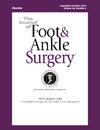Antibiotic Eluting Bone Void Filler Versus Systemic Antibiotics For Pedal Osteomyelitis
IF 1.3
4区 医学
Q2 Medicine
引用次数: 0
Abstract
Osteomyelitis complicates 20% of patients with infected diabetic foot ulcers. In this study, 2 strategies for treating pedal osteomyelitis were compared in a pilot study. This was a retrospective, non-randomized, single center 2 arm cohort study, conducted between 2020 and 2022 involving 53 patients at a tertiary limb salvage unit. All patients were managed with debridement and proximal bone biopsy. Group A was treated with systemic antibiotics for up to 6 weeks. Group B had vancomycin or gentamycin eluting bone void filler implanted into the diseased bone medullary cavity(s) and 1 week of oral antibiotics. Patients were followed independently for the primary endpoint of osteomyelitis treatment failure and secondary endpoints of amputation free survival, wound healing, minor amputation, and treatment-limiting side-effects. Survival analysis demonstrated no significant difference in treatment failure (p = .35) or amputation free survival (p = .46). Limb salvage rates were 88% in Group A and 89% in Group B. Wounds healed in 85% in Group A and 89% in Group B. Minor amputations occurred in 21% in Group A and 11% in Group B. Treatment limiting side effects occurred in 6% in Group A and were absent in Group B. In conclusion, the use of antibiotic eluting bone void filler appeared safe without extended systemic antibiotics in this study. Group B had fewer intravenous lines, requirement for home nursing, and treatment limiting side effects. A larger randomized controlled trial examining longer term clinical and radiological efficacy, treatment costs and side effects is warranted.
抗生素洗脱骨腔填充剂与全身抗生素治疗腓骨骨髓炎的对比
20% 的糖尿病足溃疡患者会并发骨髓炎。本研究在一项试点研究中比较了治疗足骨髓炎的两种策略。这是一项回顾性、非随机、单中心双臂队列研究,于 2020-2022 年间进行,涉及一家三级肢体救治单位的 53 名患者。所有患者都接受了清创术和近端骨活检。A 组接受长达 6 周的全身抗生素治疗。B 组在病变骨髓腔内植入万古霉素或庆大霉素洗脱骨空洞填充物,并口服抗生素 1 周。对患者进行独立随访,主要终点是骨髓炎治疗失败,次要终点是无截肢生存期、伤口愈合、轻微截肢和治疗限制性副作用。生存分析表明,治疗失败率(P=0.35)和无截肢生存率(P=0.46)无显著差异。肢体挽救率 A 组为 88%,B 组为 89%;伤口愈合率 A 组为 85%,B 组为 89%;轻微截肢发生率 A 组为 21%,B 组为 11%;治疗限制性副作用发生率 A 组为 6%,B 组为零。B 组的静脉注射管路、家庭护理要求和治疗副作用较少。有必要进行更大规模的随机对照试验,对长期临床和放射学疗效、治疗成本和副作用进行研究。临床证据水平:这是一项回顾性队列研究,因此临床证据级别为 2。
本文章由计算机程序翻译,如有差异,请以英文原文为准。
求助全文
约1分钟内获得全文
求助全文
来源期刊

Journal of Foot & Ankle Surgery
ORTHOPEDICS-SURGERY
CiteScore
2.30
自引率
7.70%
发文量
234
审稿时长
29.8 weeks
期刊介绍:
The Journal of Foot & Ankle Surgery is the leading source for original, clinically-focused articles on the surgical and medical management of the foot and ankle. Each bi-monthly, peer-reviewed issue addresses relevant topics to the profession, such as: adult reconstruction of the forefoot; adult reconstruction of the hindfoot and ankle; diabetes; medicine/rheumatology; pediatrics; research; sports medicine; trauma; and tumors.
 求助内容:
求助内容: 应助结果提醒方式:
应助结果提醒方式:


